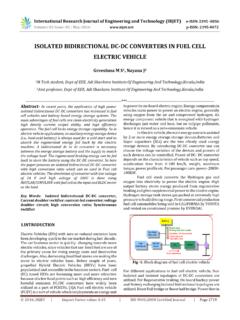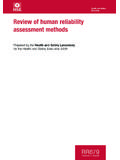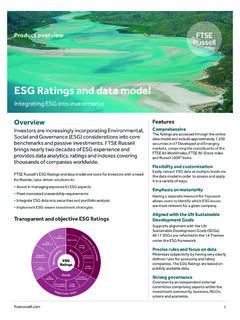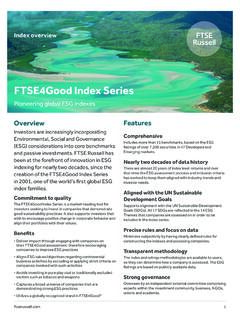Transcription of DESIGN AND FINITE ELEMENT ANALYSIS OF AIRCRAFT …
1 International Research Journal of Engineering and Technology (IRJET) e-ISSN: 2395 -0056 Volume: 04 Issue: 06 | June -2017 p-ISSN: 2395-0072 2017, IRJET | Impact Factor value: | ISO 9001:2008 Certified Journal | Page 2133 DESIGN AND FINITE ELEMENT ANALYSIS OF AIRCRAFT WING USING RIBS AND SPARS Sivarama Prasad Peruru 1 , Suman Babu Abbisetti 2 , student, mechanical enginnering Aditya Engineering College, Surampalem 2 Assistant professor,mechanical enginnering, Aditya Engineering College, Surampalem ---------------------------------------- --------------------------------**------ ---------------------------------------- -------------------------ABSTRACT - In this thesis.
2 Project detailed DESIGN of trainer AIRCRAFT wing structure made by using PRO-ENGINEER WILDFIRE Then stress ANALYSIS of the wing structure is carried out to compute the stresses at wing structure. The stresses are estimated by using the FINITE ELEMENT approach with the help of ANSYS to find out the safety factor of the structure. In a structure like airframe, a fatigue crack may appear at the location of high tensile stress. Life prediction requires a model for fatigue damage accumulation, constant amplitude S-N (stress life) data for various stress ratios and local stress history at the stress concentration. The response of the wing structure will be evaluated.
3 In this thesis, the trainer AIRCRAFT wing structure with skin, spars and ribs is considered for the detailed ANALYSIS . The wing structure consists of 15 ribs and two spars with skin. Front spar having I section and rear spar having C section. Stress and fatigue ANALYSIS of the whole wing section is carried out to compute the stresses and life at spars and ribs due to the applied pressure load. Key words: FINITE ELEMENT ANALYSIS , AIRCRAFT wing, wing with ribs and spars. I. INTRODUCTION A fixed-wing AIRCRAFT is an AIRCRAFT , such as an aero plane, which is capable of flight using wings that generate lift caused by the vehicle's forward airspeed and the shape of the wings.
4 Fixed-wing AIRCRAFT are distinct from rotary-wing AIRCRAFT [1], in which the wings form a rotor mounted on a spinning shaft, in which the wings flap in similar manner to a bird. Glider fixed-wing AIRCRAFT , including free-flying gliders of various kinds and tethered kites, can use moving air to gain height. Powered fixed-wing AIRCRAFT that gain forward thrust from an engine (aero planes) include powered par gliders, powered hang gliders and some ground effect vehicles. Fig1: air craft wing The wings of a fixed-wing AIRCRAFT are not necessarily rigid; kites, hang-gliders, variable-sweep wing AIRCRAFT and aero planes using wing-warping are all fixed-wing AIRCRAFT .
5 Most fixed-wing AIRCRAFT are flown by a pilot on board the AIRCRAFT , but some are designed to be remotely or computer-controlled. Wings The wings of a fixed-wing AIRCRAFT are static planes extending either side of the AIRCRAFT . When the AIRCRAFT travels forwards [5], air flows over the wings which are shaped to create lift. Wing structure Kites and some light weight gliders and aeroplanes have flexible wing surfaces which are stretched across a frame and made rigid by the lift forces exerted by the airflow over them [3]. Larger AIRCRAFT have rigid wing surfaces which provide additional strength. Whether flexible or rigid, most wings have a strong frame to give them their shape and to transfer lift from the wing surface to the rest of the AIRCRAFT .
6 The main structural elements are one or more spars running from root to tip, and many ribs running from the leading (front) to the trailing (rear) edge. Wing configuration The number and shape of the wings varies widely on different types. A given wing plane may be full-span or divided by a central fuselage into port (left) and starboard (right) wings. Occasionally even more wings have been used, with the three-winged triplane achieving some fame in WWI. The four-winged quadruplane and other Multiplane (aeronautics) designs have had little success. Fig2: air craft wing with ribs and spars International Research Journal of Engineering and Technology (IRJET) e-ISSN: 2395 -0056 Volume: 04 Issue: 06 | June -2017 p-ISSN: 2395-0072 2017, IRJET | Impact Factor value: | ISO 9001:2008 Certified Journal | Page 2134 Materials used in the DESIGN of AIRCRAFT The DESIGN of the AIRCRAFT has to meet specific requirements which influence the complexity of its structure and the materials used in its construction.
7 A wide range of materials may be used in the DESIGN of the AIRCRAFT to make use of properties such as strength[2], elasticity, specific weight and corrosion resistance. Different materials can also be used in the DESIGN of specific parts of the AIRCRAFT , as a function of the initial requirements of the strength-to-weight ratio and the preferential directions of the applied loads. II. LITERATURE REVIEW DESIGN and Structural ANALYSIS of the Ribs and Spars of Swept Back Wing The aim of this paper work is to DESIGN and analyze the ribs and spars of a 150 seater regional AIRCRAFT for the stresses and displacements due to the applied loads.
8 For this we did a comparative study on particular 150 seater regional AIRCRAFT [1][2][3]. The optimum DESIGN parameters are suitably selected and then the model was designed using the CATIA software. The airfoil coordinates for the model to be designed, were generated by DESIGN foil software. The major wing DESIGN parameters were explained in detail and the wing configuration has been described. Different types of loads acting on the AIRCRAFT and the wing are determined and the moments, displacements, etc., are also determined. The wing structure was also explained and functions of each component and their arrangement are also studied [7].
9 The methodology of FINITE ELEMENT method and the detailed description about various FEM tools have been studied and implemented in this work. III. PROBLEM DESCRIPTION: The objective of this project is to make a 3D model of the AIRCRAFT wing with ribs and spars and study the static[6], fatigue and modal ANALYSIS behavior of the wing by performing the FINITE ELEMENT modeling software (PRO-Engineer) was used for designing and ANALYSIS software (ANSYS) . MODELS Speeds Materials 400 Aluminium alloy 6061-T8[8], S2-glass & carbon epoxy 600 800 The methodology followed in the project is as follows: Create a 3D model of the wing with ribs and spars assembly using parametric software pro-engineer.
10 Convert the surface model into Para solid file and import the model into ANSYS to do ANALYSIS . Perform static ANALYSIS on the wing assembly for static loads. IV. INTRODUCTION TO CAD/CAE: Computer-aided DESIGN (CAD), also known as computer-aided DESIGN and drafting (CADD), is the use of computer technology for the process of DESIGN and DESIGN -documentation. INTRODUCTION TO PRO-ENGINEER Pro/ENGINEER Wildfire is the standard in 3D product DESIGN , featuring industry-leading productivity tools that promote best practices in DESIGN while ensuring compliance with your industry and company standards. Integrated Pro/ENGINEER CAD/CAM/CAE solutions allow you to DESIGN faster than ever, while maximizing innovation and quality to ultimately create exceptional products.


















